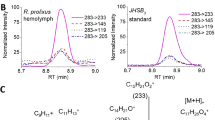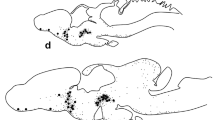Abstract
Biosynthesis and secretion of prothoracicotropic hormone (PTTH) of diapause- and nondiapause-destined individuals in Helicoverpa armigera were studied using whole-mount immunocytochemistry and enzyme-linked immunosorbent assay (ELISA). The immunocytochemistry revealed that PTTH is expressed in two pairs of lateral neurosecretory cells of the brain. The presence of immunoreactivity has not significant difference between the brains of the diapause- and nondiapause-destined 6th instar larvae. However, the obvious differences of expressional pattern from day 4 pupae were observed between the two types. PTTH titers in hemolymph from the 6th instar larvae to pharate adults were measured by the ELISA. Although there were similar titer changes between the two types of individuals at the larval stage, a significant difference from developmental expression was detected at the pupal stage, suggesting that the expression and secretion of PTTH does play a crucial role in regulation of pupal diapause of H. armigera.
Similar content being viewed by others
References
Kataoka H, Nagasawa H, Isogai I. Isolation and partial characterization of a prothoracicotropic hormone of the silkworm, Bombyx mori. Agric Biol Chem, 1987, 51: 1067–1076
Kawakami A, Kataoka H, Oka T, et al. Molecular cloning of the Bombyx mori prothoracicotropic hormone. Science, 1990, 247(4948): 1333–1335
Sauman I, Reppert S M. Molecular characterization of prothoracicotropic hormone (PTTH) from the giant silkmoth Antheraea pernyi: Developmental appearance of PTTH-expressing cells and relationship to circadian clock cells in central brain. Dev Biol, 1996, 178(2): 418–429
Sehnal F, Hansen I, Scheller K. The cDNA-structure of the prothoracicotropic hormone (PTTH) of the silkmoth Hyalophora cecropia. Insect Biochem Mol Biol, 2002, 32(2): 233–237
Shionoya M, Matsubayashi H, Asahina M, et al. Molecular cloning of the prothoracicotropic hormone from the tobacco hornworm, Manduca sexta. Insect Biochem Mol Biol, 2003, 33(8): 795–801
Xu W H, Rinehart J P, Denlinger D L. Structural characterization and expression analysis of prothoracicotropic hormone in the com earworm, Helicoverpa zea. Peptides, 2003, 24(9): 1319–1325
Xu W H, Denlinger, D L. Molecular characterization of prothoracicotropic hormone and diapause hormone in Heliothis virescens during diapause, and a new role for diapause hormone. Insect Mol Biol, 2003, 12(5): 509–516
Wei Z J, Zhang Q R, Kang L, et al. Molecular characterization and expression of prothoracicotropic hormone during development and pupal diapause in the cotton bollworm, Helicoverpa armigera. J Insect Physiol, 2005, 51(6): 691–700
Xu J, Su J Y, Shen J L, et al. Molecular characterization and developmental expression of the gene encoding the prothoracicotropic hormone in the beet armyworm, Spodoptera exigua. Chin Sci Ser C-Life Sci, 2007, 50(4): 466–472
Westbrook A L, Bollenbacher W E. The development of identified neurosecretory cells in the tobacco hornworm, Manduca sexta. Dev Biol, 1990, 140(2): 291–299
Dai J L, Mizoguchi A, Satake S, et al. Developmental changes in the prothoracicotropic hormone content of the Bombyx mori brain-retrocerebral complex and hemolymph: Analysis by immunogold electron microscopy, quantitative image analysis, and time-resolved fluoroimmunoassay. Dev Biol, 1995, 171(1): 212–223
Mizoguchi A, Dedos S G, Fugo H, et al. Basic pattern of fluctuation in hemolymph PTTH titers during larval-pupal and pupal-adult development of the silkworm, Bombyx mori. Gen Comp Endocrinol, 2002, 127(2): 181–189
Sun J S, Zhang T Y, zhang Q R, et al. Effect of the brain and suboesophageal ganglion on pupal development in Helicoverpa armigera through regulation of FXPRL amide neuropeptides. Regul Pept, 2003, 116(1–3): 163–171
Denlinger D L. Hormonal control of diapause. In: Kerkut G A, Gilbert L I, eds. Comprehensive Insect Physiology Biochemistry and Pharmacology. New York: Pergamon Press, 1985. 353–411
Sun J S, Chen F S, Xu W H. Localization, expression, and secretion pathway of diapause hormone in embryo and larva of the silkworm, Bombys mori. Chin Sci Bull, 2004, 49(13): 1386–1391
Sun J S, Zhang Q R, Zhang T Y, et al. Developmental expression of FXPRL amide neuropeptides in peptidergic neurosecretory cells of diapause- and nondiapause-destined individuals of the cotton bollworm, Helicoverpa armigera. Gen Comp Endocrinol, 2005, 141(1): 48–57
Liu J, Shi G P, Zhang W Q, et al. Cathepsin L function in insect molting: Molecular cloning and functional analysis in cotton bollworm, Helicoverpa armigera. Insect Mol Biol, 2006, 15(6): 823–834
Author information
Authors and Affiliations
Corresponding author
Additional information
Supported by the National Basic Research Program of the Ministry of Science and Technology, People’s Republic of China (Grant No. 2006CB102001), and the National Natural Science Foundation of China (Grant No. 30370198).
About this article
Cite this article
Hou, C., Xu, W. Synthesis dynamic and developmental profile of prothoracicotropic hormone between diapause- and nondiapause-destined individuals in Helicoverpa armigera . CHINESE SCI BULL 52, 2095–2099 (2007). https://doi.org/10.1007/s11434-007-0310-1
Received:
Accepted:
Issue Date:
DOI: https://doi.org/10.1007/s11434-007-0310-1




